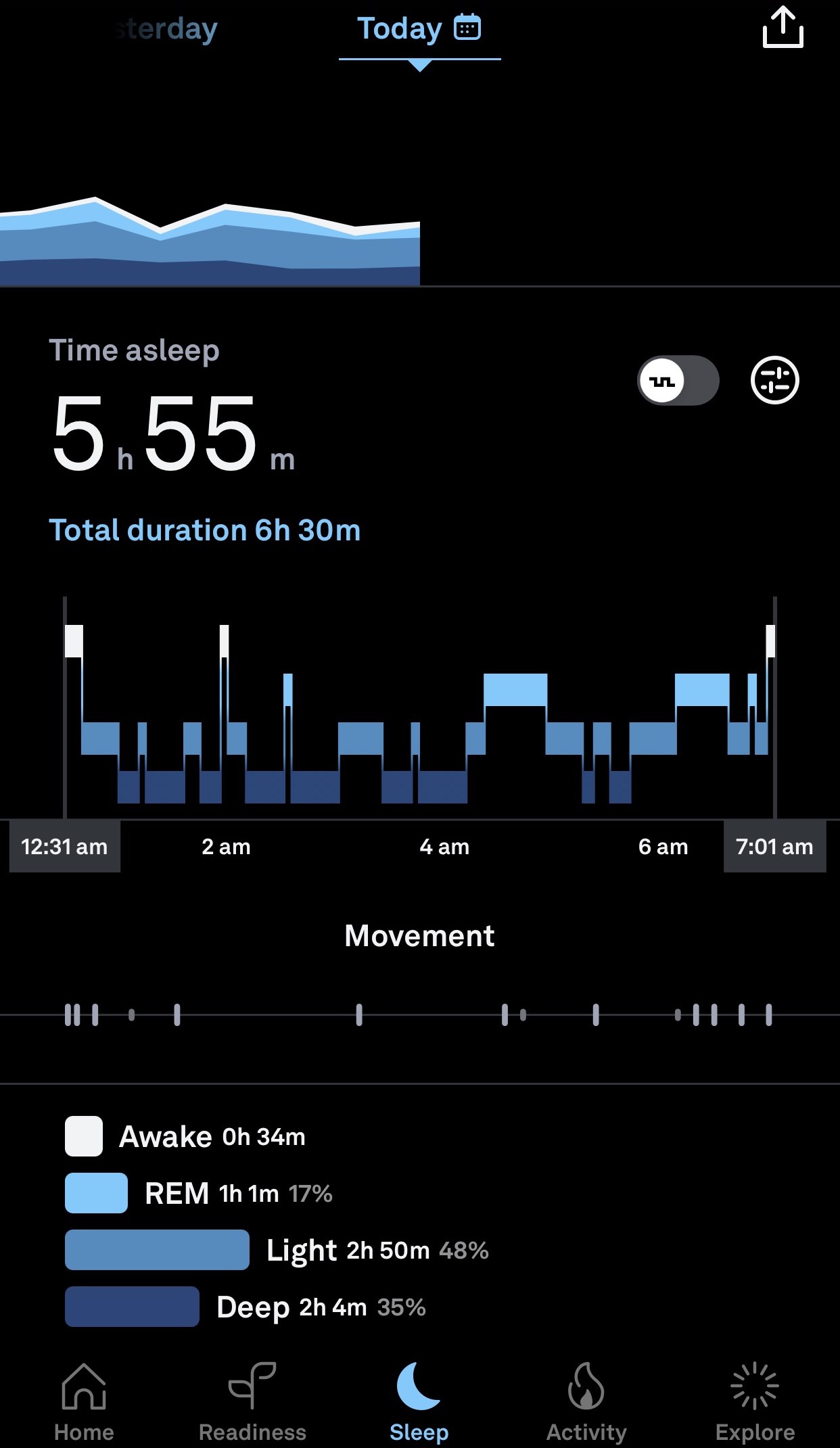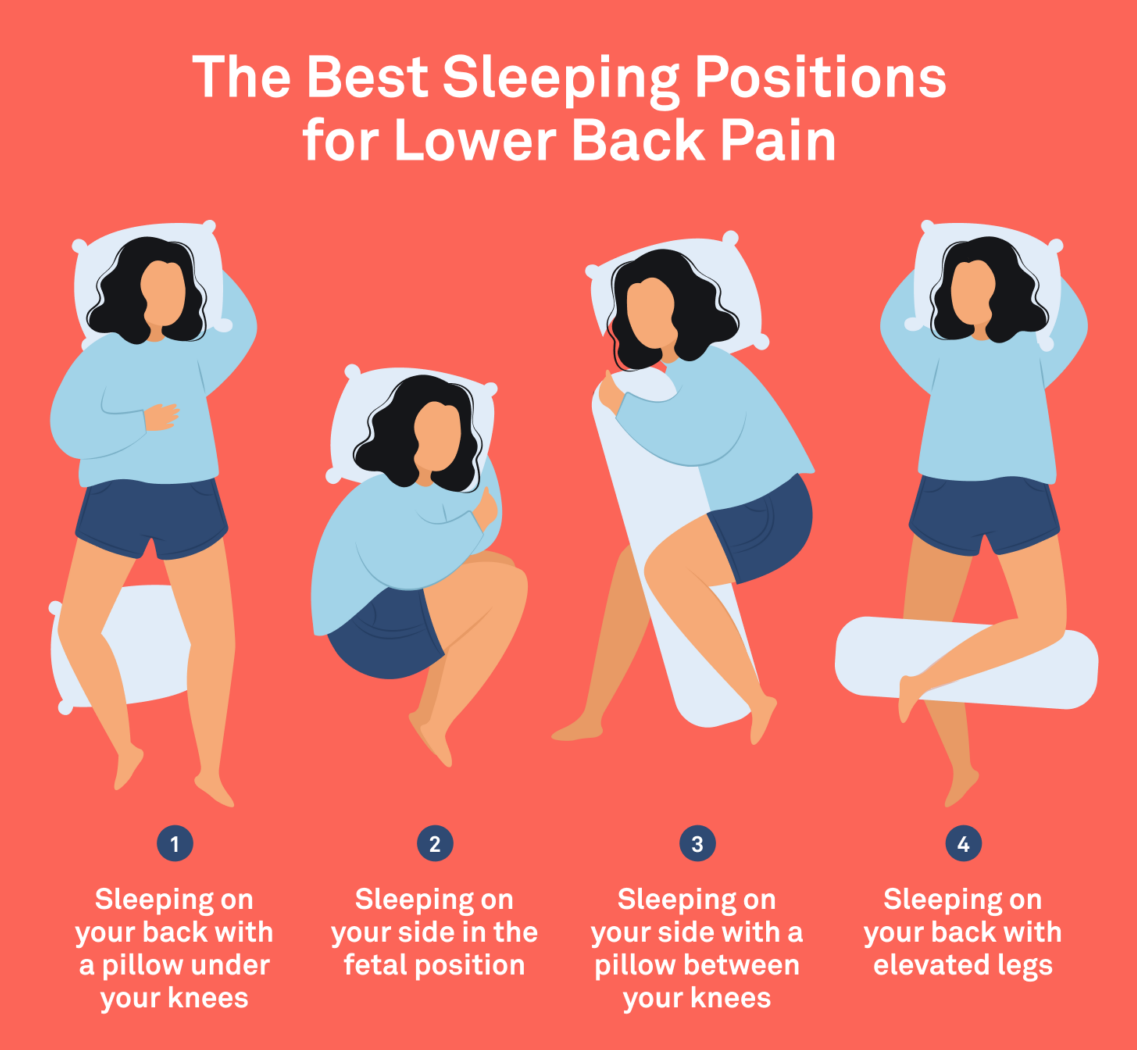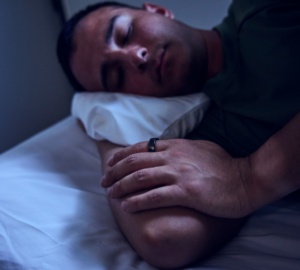The lower back plays a crucial role in supporting your body and maintaining balance. Given its important function, it’s no surprise that the lower back is more susceptible to injury. Lower back pain affects millions of people around the world.
Unfortunately, this type of pain can affect multiple aspects of your daily life, including sleep. The complex relationship between pain and sleep often creates a vicious cycle: The pain disrupts sleep, keeping you awake at night as you try to find the best sleeping position for lower back pain relief. Conversely, not sleeping enough — or not sleeping well — can worsen back pain.
Use Oura to Track Your Sleep

In the Oura App, you can check your Movement graph on the Sleep Tab to identify if restlessness caused by lower back pain might be affecting your sleep quality.
For instance, Matthew, an Oura member, shared that he noticed more movement on nights when he didn’t stretch his back muscles: “There’s a big difference in nights where I’ve gone to the gym and stretched my back out vs. days when I can’t go and it’s really bothering me. Now I’m really making time to stretch it whenever I can now.”
Plus, excess movement during the night can influence elements of your Sleep Score, leading to a higher Awake Time and lower Efficiency, as seen in the Sleep tab.
By recognizing your movement patterns and understanding their impact on your sleep data, you can gain insights into whether nighttime movement is negatively affecting your sleep quality.
RELATED: Restless Sleep? How to Reduce Tossing and Turning at Night
Causes of Lower Back Pain
While many factors can contribute to lower back pain, understanding the common root causes is essential for effective management and prevention.
Muscle Strain and Sprain
One of the most common causes of lower back pain is muscle strain or sprain. This often occurs due to sudden or improper movements or lifting heavy objects without proper technique.
Physical Activity Levels, Weight, and Posture
When it comes to physical activity, both overexertion and a lack of exercise can lead to lower back pain.
Intense or improper physical activity can lead to muscle and ligament strain, muscle spasms, inflammation, and even micro-tears in the muscles or tissues around the lower back. These injuries can result in acute lower back pain that may persist for a few days.
“Straining a muscle or spraining a ligament are the most common causes of lower back pain,” says Dr. Kenneth Palmer, an orthopedic surgeon specializing in spine surgery at Houston Methodist. “While they can be serious, these common causes of lower back pain aren’t long-lasting — taking anywhere from a few days to heal or, at most, a few months.”
On the other hand, a sedentary lifestyle can also cause lower back pain in a few ways.
First, when you don’t use your muscles regularly, they become weak and less flexible. This can make it harder to support your spine and can lead to pain.
Second, a lack of physical activity can lead to obesity, and the excess weight can put a strain on the lower back muscles and joints, leading to pain. Lastly, a lack of physical activity can contribute to poor posture, which can also put a strain on the lower back.
With Oura, you can track your daily movement through the Activity Score, which shows you how well you’re balancing your activity, inactivity, and rest. Plus, Oura’s inactivity alerts will prompt you to stretch after 50 minutes of inactivity, so you can avoid back injury.
READ MORE: Oura Introduces Two New Personalized Activity Features
Health Conditions
Several health conditions can cause lower back pain, with degenerative disc disease (DDD), herniated disc, sciatica, osteoarthritis, and spinal stenosis being among the most common.
- DDD occurs when the intervertebral disks in the lower back break down over time, causing pain, stiffness, and decreased range of motion in the lower back.
- A herniated disc occurs when the soft center of a disc in the spine pushes out through the tough outer layer of the disc. This can cause lower back pain if the herniation occurs in the lower region of the spine.
- Sciatica is caused by pressure on the sciatic nerve, which is a large nerve that runs from the lower back down the legs. As a result, the condition causes pain that radiates from the lower back down the back of one or both legs.
- Osteoarthritis of the spine occurs when the cartilage between spinal joints gradually deteriorates, causing inflammation and pain, which is typically felt in the lower back. In some cases, this condition results in spinal stenosis.
- Spinal stenosis is a narrowing of the spinal canal. This can put pressure on the nerves in the lower back, causing pain
Types of Lower Back Pain
Lower back pain can be categorized into two primary types: chronic and acute.
Chronic pain lasts for three months or longer, even after the underlying cause or initial injury has been treated. Acute lower back pain, on the other hand, only lasts a short time, usually spanning from a few days to a couple of weeks. In most cases, the pain can be traced back to a specific incident or injury, and it will go away once you’re healed.
In the Oura App, you can use Rest Mode to optimize your recovery after a back injury. Enabling this mode disables any activity-related contributors and adjusts your Sleep and Readiness insights to prioritize rest and recovery.
The Best Sleeping Position for Lower Back Pain
Discovering the best sleeping position for your lower back can help relieve the pain you feel in your lower back, while enabling you to sleep more soundly.
The key is supporting the natural curvature of your spine during sleep. When you do so, you’ll minimize unnecessary stress on your back, allowing muscles and ligaments to relax. This, in turn, improves blood circulation and facilitates the body’s repair processes.

1. Side Sleeping Position (With a Pillow Between Your Knees)
Sleeping on one side helps maintain the natural alignment of your spine. This means your spine is not curved or twisted, which can put pressure on your back muscles and nerves.
The best side to sleep on will depend on your needs. For example, if you have heart problems, you may find sleeping on the right side more comfortable. On the other hand, if you have gastrointestinal problems or are pregnant, the left side may be more beneficial.
To optimize this sleeping position:
- Place a supportive pillow between your knees to help keep your hips, pelvis, and spine in proper alignment.
- Bend your knees slightly to reduce strain on your hips and lower back.
- Ensure that your pillow keeps your head in line with your spine and has adequate height to prevent straining your neck or back.
2. Side Sleeping Position (Fetal Position)
If you have a herniated disc and spinal stenosis, sleeping in the fetal position can help. In this position, you lie on your side with your knees drawn up towards your chest.
Curling your torso into a fetal position opens the space between the bones that make up the spine, which can ease tension on the discs and nerves in your lower back. Similarly, curling up helps relieve pressure on the nerve root when you have spinal stenosis.
To optimize this sleeping position:
- Use a pillow under your head to support the head and neck.
- Avoid drawing your knees up too tightly, especially if you have tight hip muscles or arthritis, as this might worsen discomfort.
- Alternate sides occasionally to prevent any imbalances or straining on one side of your body.
READ MORE: 8 Popular Sleeping Positions & What They Mean for Your Health
3. Sleeping on Your Back
The back sleeping position is generally considered one of the best for individuals with lower back pain. It allows your entire spine to rest in a neutral sleeping posture, promoting proper alignment and reducing the risk of pain and discomfort. Plus, your weight is evenly distributed across the widest area of your body, preventing any undue stress on specific areas of your back.
To optimize this sleeping position:
- Ensure that your mattress is firm enough to support your lower back well. A mattress that is too soft might cause your lower back to sink, leading to strain.
- Consider placing a small, thin pillow or rolled towel under your knees to maintain the natural curve of your lower back and enhance comfort.
4. Sleeping on Your Back with Elevated Legs
Lying on your back with your legs elevated, either by placing them on a stack of pillows or using an adjustable bed, can help lower back pain. For one, this position encourages relaxation of the muscles in the lower back and pelvic region, which can alleviate tension and discomfort. In addition, raising your legs above heart level can enhance blood circulation, reducing inflammation and swelling in the lower back.
To optimize this sleeping position:
- Ensure that your knees are slightly bent while elevating your legs to avoid straining the hamstrings.
- Avoid elevating your legs too high, as this can lead to strain on the lower back and pelvis.
Stomach Sleeping Positions for Lower Back Pain
Unfortunately, sleeping on your stomach is the worst sleeping position for your spine, according to Dr. Raymond J. Hah, a spine surgeon at Keck Medicine of USC.
Hah warns that sleeping in this position not only flattens your spine’s natural curve, putting the most pressure on your spine’s muscles and joints, but also makes you turn your neck, which can cause upper back and neck pain.
If you have lower back pain, you will probably want to avoid this position. However, individual preferences and conditions vary, and you may find yourself sleeping on your stomach more often than not.
To improve a stomach sleeping position:
- Place a pillow or rolled-up towel under your pelvis to help maintain the natural curve of your lower back and reduce some strain on the lumbar region.
- Avoid a thick pillow for your head as this can force your head and neck into an unnatural position.
- Use a supportive, firm or medium-firm mattress that provides adequate support for your body. A mattress that is too soft can cause your lower back to sink in, leading to increased pressure and pain.
If you experience discomfort or increased pain in this position, consider transitioning to other sleep positions.
Using Oura to Sleep Better With Lower Back Pain
Your body heals itself during high-quality sleep, which is why it’s essential to focus on getting a good night’s rest — especially if you’re dealing with lower back pain.
Below are a few pointers to get more restorative sleep; read more about deep sleep here.

1. Stick to a Sleep Schedule
Consistency helps regulate your body’s internal clock, promoting better sleep quality. With Oura’s Bedtime Guidance feature, you can discover the best bedtime for you and get tips on how to stick to it.
2. Create an Ideal Sleeping Environment
Ensure your sleep space is comfortable, quiet, and cool. Invest in a high-quality, supportive mattress that aligns with your preferred sleep position. A medium-firm mattress is often recommended for those with lower back pain. Additionally, use supportive pillows to maintain proper spinal alignment throughout the night.
3. Do Some Gentle Stretches Before Bed
Gentle stretches can help ease tension in your lower back and improve flexibility. Simple stretches like knee-to-chest stretches and gentle twists can be great for relieving tightness.
4. See a Healthcare Professional
If you have chronic or severe lower back pain, consider consulting a healthcare professional for personalized advice.
5. Take Note of Your Habits and Lifestyle Choices
Research has established a link between smoking and low back pain, indicating that smoking can worsen the pain. Furthermore, ongoing research suggests a potential association between alcohol and caffeine and lower back pain.
Oura Tags allow you to track how specific factors such as caffeine and alcohol intake might affect your sleep quality.
Over time, the Trends view in the Oura App offers a visual representation of the impact these factors have on your sleep, allowing you to make informed decisions about your lifestyle choices.
RELATED: Oura Members Share Their Top Tips to Get More Deep Sleep




